Classification Of Malocclusion Important Notes
Angle’s classification:
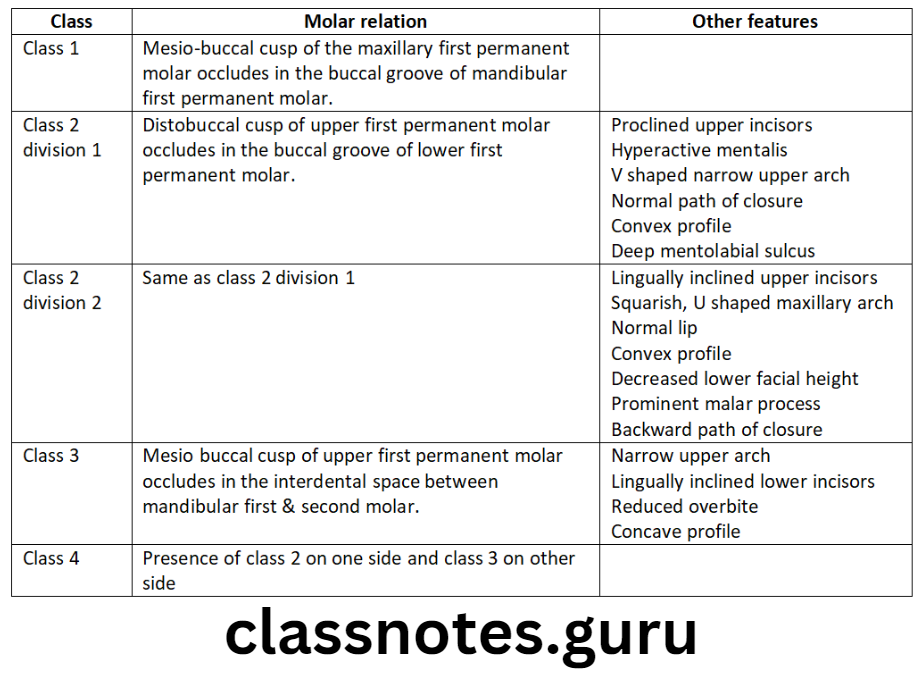
- Dewey’s modification:
- Class 1 modifications:
- Type 1 – Bunched/crowded interiors
- Type 2 – Protursive maxillary anterior
- Type 3 – Anterior crossbite
- Type 4 – Posterior crossbite
- Type 5 – Mesial drifting of permanent molar due to premature loss of 2nd deciduous molar
- Class 3 modifications:
- Type 1 – When upper and lower arches are viewed separately they appear normal
- When a patient is made to occlude suggest forwardly placed mandibular dental arch
- Type 2 – Mandibular incisors are crowded and in lingual relation to maxillary incisors
- Type 3 – Maxillary incisors are crowded and in lingual relation to mandibular incisors
- Type 1 – When upper and lower arches are viewed separately they appear normal
- Class 1 modifications:
- Simon’s classification”
- Described malocclusion in all the three planes
- Frankfort Horizontal Plane:
- Plane – Vertical
- Extend – Upper margin of external auditory meatus to infra-orbital margin
- Terminologies:
- Attraction – When the dental arch is closer to the plane
- Abstraction – When the dental arch is far away from the plane
- Orbital plane
- Plane – Horizontal
- Extend – Perpendicular to Frankfort plane
- From the bony orbital margin passes through a distal third of the upper canine “SIMON’s LAW OF CANINE”
- Terminologies:
- Protraction – Dental arch farther from the orbital plane
- Retraction – Dental arch close to the orbital plane
- Mid-Saggital Plane:
- Plane – Transverse
- Terminologies:
- Distraction – The dental arch is away from the plane
- Contraction – Dental arch close to the plane
- Ackermann Profitt classification:
- Step 1 – Alignment:
- Significance – Assessment of alignment and symmetry of dental arch
- Classified into:
- Ideal
- Crowded
- Spaced
- Step 2 – Profile:
- Involves:
- Facial Profile
- Straight
- Convex
- Concave
- Facial divergence
- Anterior
- Posterior
- Facial Profile
- Step 3 – Type:
- Represents transverse dental and skeletal relationship
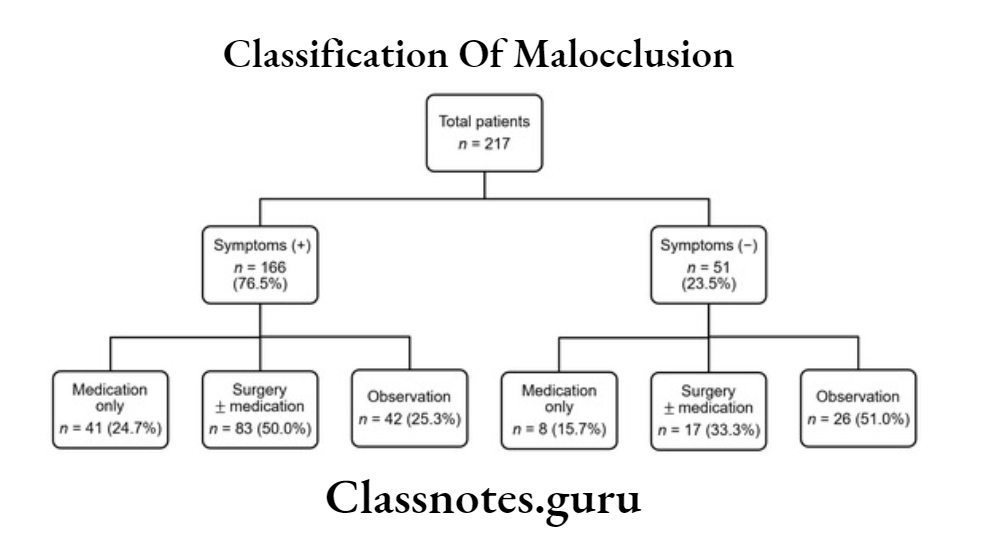
Involves:

- Step 4 – Class:
- Shows sagittal relationship
- Involves:
- A. Angles class 1 B. Skeletal
- Class 2 – Dental
- Class 3
- A. Angles class 1 B. Skeletal
- Step 5 – Bite Depth:
- Represents vertical relationship
- Involves
- Open bite
- Anterior deep bite
- Posterior collapsed bite
- May be
- Dental
- Skeletal
- Open bite
- Step 4 – Class:
Classification Of Malocclusion Long Essays
Question 1. Classify different malocclusions. Write a note on Angle’s classification of malocclusion.
Answer.
Classification Of Malocclusion:
Intra-arch Malocclusion:
- Includes variations in individual tooth position and affecting that of a group of teeth within an arch
Distal tipping: The crown of the tooth is tilted distally
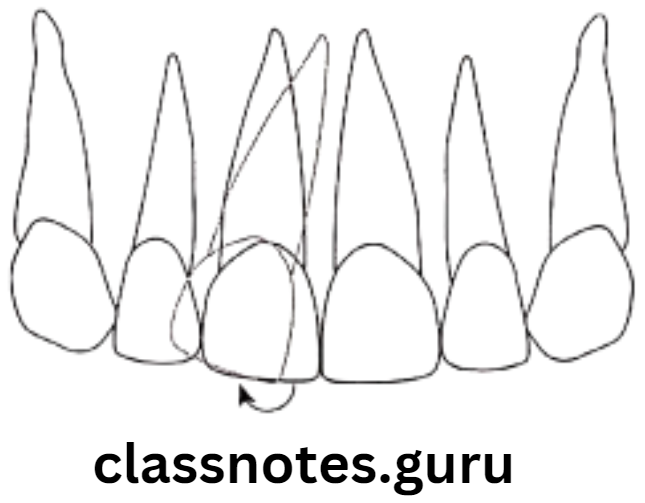
Mesial tipping: The crown of the tooth is tilted mesially
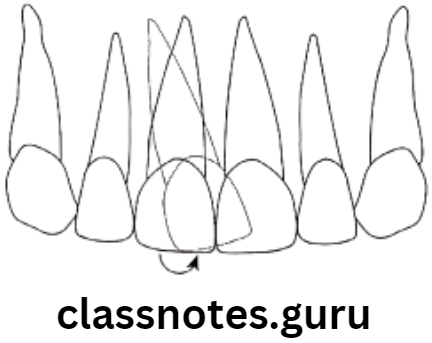
Buccal tipping: The crown of the tooth is tilted labially

Read And Learn More: Orthodontics Short And Long Essay Question And Answers
Palatal tipping: The crown of the tooth is tilted palatally

Mesial displacement: Bodily movement of the tooth is the mesial direction
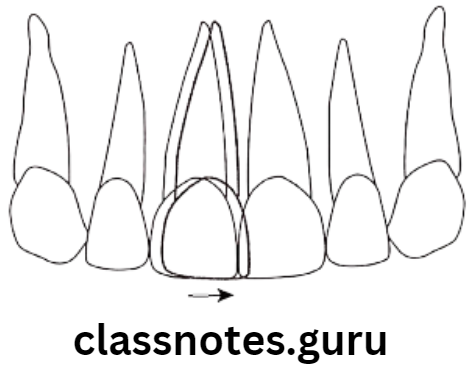
Distal displacement: Bodily movement of the tooth is the distal direction
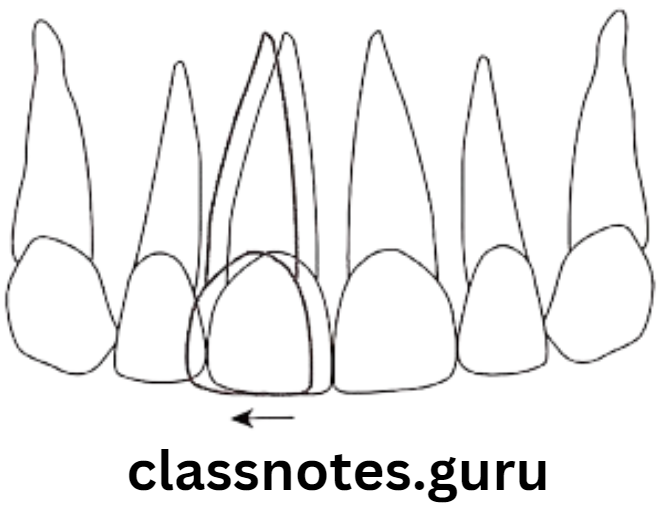
Buccal displacement: Bodily movement of tooth buccally

Lingual displacement: Bodily movement of tooth lingually
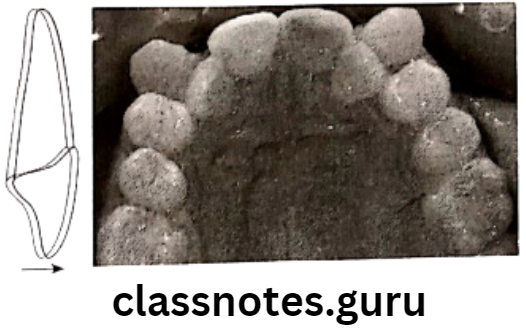
Infra occlusion: The tooth has not erupted enough as compared to other teeth in the arch

Supra occlusion: Tooth has over-erupted as compared to other teeth in the arch

Rotations: Tooth movement around its long axis
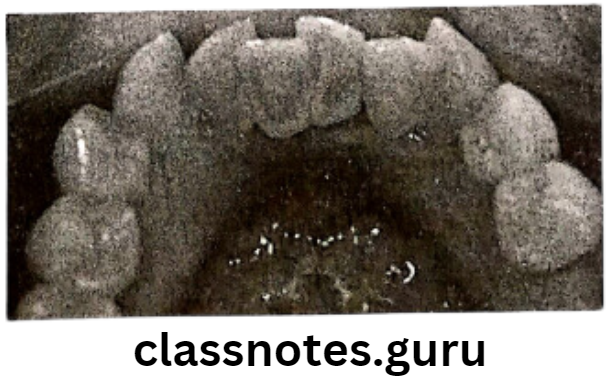
Disto-lingual/Mesio-buccal rotation: Movement of tooth around its long axis such that the distal aspect is more lingually placed

Mesio-lingual/Disto-buccal rotation: Movement of tooth around its long axis such that the mesial aspect is more lingually placed
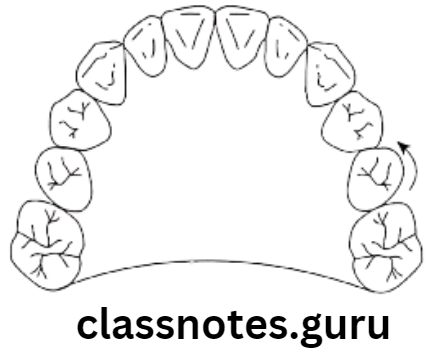
Transposition: Two teeth have exchanged their places.
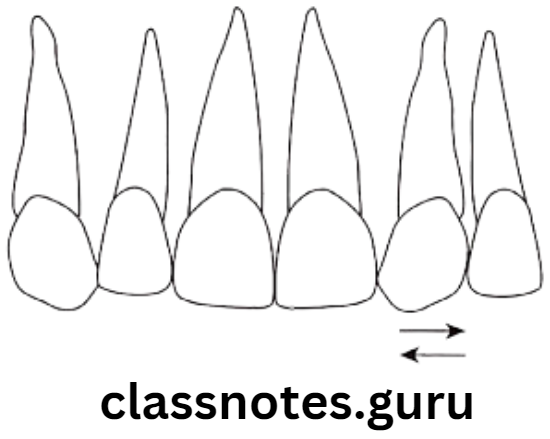
Inter-arch Malocclusion
Includes abnormal relationship between two teeth or groups of teeth of one arch to another arch.
- Sagittal Plane Malocclusion:
- Pre-normal occlusion – Mandible is forwardly placed when the patient bites in centric occlusion
- Post-normal occlusion – Mandible is distally placed when the patient bites in centric occlusion
- Vertical Plane Malocclusion:
- Deep bite: Excessive overlapping of upper and lower anterior
- Open bite: No overlapping between upper and lower anterior
- Transverse Plane Malocclusion:
- Crossbite – Abnormal transverse relationship between upper and lower arches
Skeletal Malocclusion
Occur due to abnormalities in the maxilla/mandible
- Saggital Plane:
- Prognathism – forwardly placement of the jaw
- Retrognathism – backwardly placement of the jaw
- Transverse Plane:
- Narrowing of jaw
- Widening of jaw
- Vertical Plane:
- Effecting lower facial height
Angle’s Classification of Malocclusion:
- Described by Edward H.Angle in 1899
Class 1:
- Mesio-buccal cusp of the maxillary first permanent molar occludes in the buccal groove of the mandibular first permanent molar
- Normal skeletal relation
- Normal muscle activity
- Presence of irregularities such as crowding, spacing, rotation, missing tooth, etc.
Bimaxillary protrusion:
- Molar relation is class 1
- Both arches are forwardly placed
Class 2:
- Disto-buccal cusp of upper first permanent molar occludes in the buccal groove of lower first permanent molar
Class 2, Division 1:
- Molar relation class 2
- Proclined upper incisor
- Increase in overjet
- Deep bite
- Abnormal muscle activity
- Upper lip hypotonic, short
- No lip seal formed
- Lip trap
- Narrowing of the maxillary arch
- Hyperactive mental activity and buccinators activity
- Convex facial profile
- Deep palate
- Increased lower facial height
Class 2, Division 2:
- Molar relation class 2
- Lingually placed upper central incisors
- Canines labially tilted
- Deep bite
- Square shaped arch
- Normal perioral muscle activity
- Backward path of closure
- Straight facial profile
- Decreased overjet
- Decreased facial height
Class 2, sub-division:
- Class 2 molar relation on one side of the arch and class 1 on the other side
Class 3:
- Mesio-buccal cusp of upper first molar occludes in interdental space between mandibular first and second molar
- Concave facial profile
- True class 3:
- Genetic in origin
- True Class Causes:
- Large mandible
- Forwardly placed mandible
- Retro positioned maxilla
- Small maxilla
- Combination
- True Class Features:
- Lingually inclined lower incisors
- Normal overjet/edge-to-edge/anterior crossbite
- Narrow maxillary arch
- Pseudo Class 2:
- Forward movement of the mandible during jaw closure
- Pseudo-Class Causes:
- Occlusal prematurities
- Premature loss of deciduous posterior
- Enlarged adenoids
Class 3 Subdivision:
- Class 1 molar relation on one side of the arch and class 3 on the other side

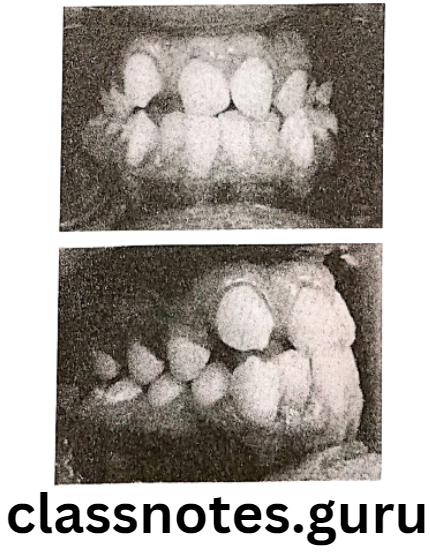
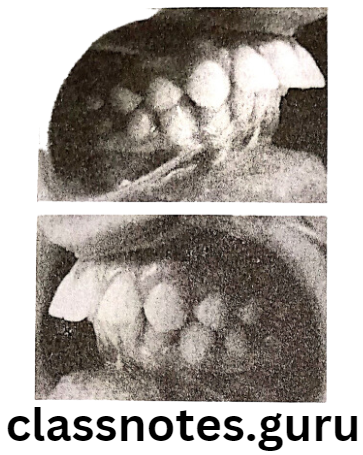
Limitations Of Malocclusion:
- Classification is done only in the antero-posterior plane
- 1st permanent molar is considered a fixed points
- Useless if 1st permanent molar is absent
- Does not differentiate between skeletal and dental malocclusion
- Does not highlight the etiology of malocclusion
- Individual tooth positions are not considered
Question 2. What are the six keys of normal occlusion and what are the basis, merits, and demeritsclassificationiof ficationthe malocclusion?
Answer.
By Andrew in 1970’sagittal
Key 1 – Molar interarch relationship:
- The mesiobuccal cusp of the upper first molar includes in groove between the mesial and medial buccal cusp of the lower first molar
- The mesiolingual cusp of the upper first molar should occlude in the central fossa of the lower first molar
- A distal marginal ridge of the upper first molar should occlude with a mesial marginal ridge of the lower second molar
Key – 2: Mesiodistal crown angulation:
- The gingival part of the long axis of clinical crown must be distal to the occlusal part of it.
Key – 3: Labio-Lingual Crown Inclination:
- If the gingival area of the crown is more lingually placed than the occlusal area – It is called Positive crown inclination
- If the gingival area of the crown is more labially placed than the occlusal area – It is called Negative crown inclination.
- Positive – Maxillary incisors
- Negative – Mandibular incisors, Maxillary and mandibular posteriors
Key – 4: Absence of Rotation
- There should not be any rotation of teeth
- Rotated posteriors – occupy more space
- Rotated interiors – occupy less space
Key 5 – Tight contacts:
- There should be tight contact between teeth
Key 6 – Curve of Spee:
- The curve of Spee should not exceed 1.5 mm
Key 7 – Bolton’s Analysis:
- Gives the mesiodistal width of maxillary and mandibular posteriors.
Angle’s Classification Of Malocclusion
Basis:
- Angle’s classification is based on the mesiodistal relation of the teeth, dental arches, and jaws
- According to Angle, the maxillary first permanent molar is key to occlusion
- Based on the relation of the lower permmsolarirst m solar to the upper first permanent molar, he classified malocclusion into three main classes: class 1, class 2, and class 3
Merits Of Malocclusion:
- It is simple to apply
Demerits Of Malocclusion:
- The classification cannot be considered in transverse and vertical plane
- Angle considered the first permanent molar as a fixed point in the skull but it is not so
- The classification cannot be applied if the first permanent molars are extracted or missing
- Classification cannot be applied to deciduous dentition
- The classification does not differentiate between skeletal and dental malocclusion
- It does not highlight the etiology of malocclusion
- Individual tooth malposition is not considered
Classification Of Malocclusion Short Essays
Question 1. Class 2 division 2.
Answer.
Class 2 Division 2
- Class 2 Division 2 is characterized by a class 2 molar relationship with reclined upper centrals that are overlapped by the lateral incisors
- Class 2 molar relation
- The lower dental arch is distally positioned about the upper arch
- The distobuccal cusp of the upper first molar occludes with the mesiobuccal groove of the lower first molar
- Class 2 canine relation
- The distal incline of the upper canine occludes with the mesial incline of the lower canine
- Line of occlusion
- The line of occlusion is altered
- Other clinical features
- Molars in distocclusion
- Retroclined central incisors and rarely other interiors as well
- Deep bite
- Broad square face with a pleasing straight profile
- Backward path of closure
- Deep mentolabial sulcus
- Absence of abnormal muscle activity
Question 2. Class 2 division 1 versus Class 2 division 2.
Answer.
Class 2 Division 1 versus Class 2 Division 2
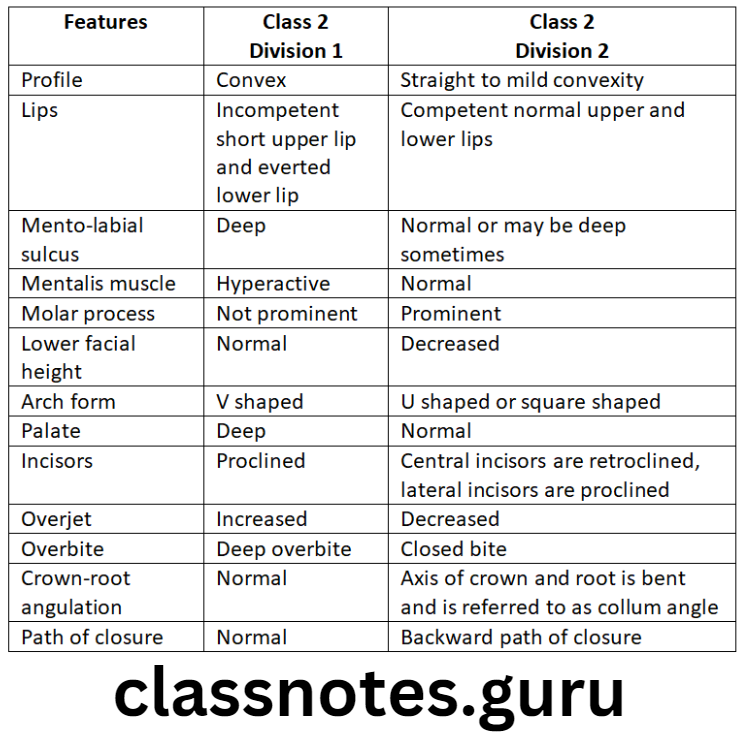
Question 3. Class 2 of Angle’s classification.
Answer.
Class 2 of Angle’s classification
- Disto-buccal cusp of upper first permanent molar occludes in the buccal groove of lower first permanent molar
Class 2, Division 1:
- Molar relation class 2
- Proclined upper incisor
- Increase in overjet
- Deep bite
- Abnormal muscle activity
- Upper lip hypotonic, short
- No lip seal formed
- Lip trap
- Narrowing of the maxillary arch
- Hyperactive mental activity and buccinators activity
- Convex facial profile
- Deep palate
- Increased lower facial height
Class 2, Division 2:
- Molar relation class 2
- Lingually placed upper central incisors
- Labially tilted upper lateral incisor
- Canines labially tilted
- Deep bite
- Square shaped arch
- Normal perioral muscle activity
- Backward path of closure
- Straight facial profile
- Decreased overjet
- Decreased facial height
Class 2, sub-division:
- Class 2 molar relation on one side of the arch and class 1 on the other side
Question 4. Class 3.
Answer.
Class 3
- Mesio-buccal cusp of upper first molar occludes in interdental space between mandibular first and second molar
- Concave facial profile
True Class 3 – Genetic In Origin
- Genetic In Origin Causes:
- Large mandible
- Forwardly placed mandible
- Retro positioned maxilla
- Small maxilla
- Combination
- Genetic In Origin Features:
- Lingually inclined lower incisors
- Normal overjet/edge of edge/ anterior crossbite
- Narrow maxillary arch
Pseudo Class 3:
Forward movement of the mandible during jaw closure
- Pseudo-Class Causes:
- Occlusal prematuritires
- Premature loss of deciduous posterior
- Enlarged adenoids
Class 3 sub-division:
- Class 1 molar relation on one side of the arch and class 3 on the other side
Question 5. Dewey’s modification.
Answer.
Dewey’s modification
Dewey divided Angle’s class 1 into 5 types and class 3 into three types
Class 1 Modifications:
- Type 1: Bunched/crowded interiors
- Type 2: Protursive maxillary anterior
- Type 3: Anterior crossbite
- Type 4: Posterior crossbite
- Type 5: Mesial drifting of permanent molar due to premature loss of 2nd deciduous molar
Class 3 Modifications:
- Type 1: When upper and lower arches are viewed separately they appear normal
- When a patient is made to occlude suggest forwardly placed mandibular dental arch
- Type 2: Mandibular incisors are crowded and in lingual relation to maxillary incisors
- Type 3: Maxillary incisors are crowded and in lingual relation to mandibular incisors
Question 6. Simnon’s classification.
Answer.
Simon’s classification
- By Simon
- Described malocclusion in all the three planes
Frankfort Horizontal Plane:
- Plane: Vertical
- Extend: Upper margin of external auditory meatus to infra-orbital margin
- Terminologies:
- Attraction: When the dental arch is closer to the plane
- Abstraction: When the dental arch is far away from the plane
Orbital plane:
- Plane: Horizontal
- Extend: Perpendicular to Frankfort plane
- From the bony orbital margin passes through a distal third of the upper canine “SIMON’s LAW OF CANINE”
- Terminologies:
- Protraction: Dental arch farther from the orbital plane
- Retraction: Dental arch close to the orbital plane
Mid-Sagittal Plane:
- Plane: Transerse
- Terminologies:
- Distraction: The dental arch is away from the plane
- Contraction: Dental arch close to the plane
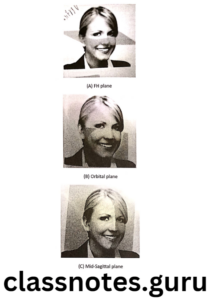
Question 7. Venn Diagram/Ackemann Profit Classification.
Answer.
Venn Diagram
- Proposed by Ackeman and Profit in 1960
Venn Diagram Features:
- Consideration of vertical, transverse, and antero-posterior mal-relations
- Evaluations of crowding and arch symmetry
- Inclusion of incisor protrusion
Step 1 – Alignment:
Significance: Assessment of alignment and symmetry of dental arch
Classified into:
- Ideal
- Crowded
- Spaced
Step 2 – Profile:
Involves:
- Facial Profile:
- Straight
- Convex
- Concave
- Facial divergence:
- Anterior
- Posterior
Step 3 – Type:
Represents transverse dental and skeletal relationship
Involves:

Step 4 – Class:
- Shows sagittal relationship
Involves:
- Angles class 1
- Class 2
- Class 3
- Skeletal
- Dental
Step 5 – Bite Depth:
- Represents vertical relationship
Involves:
- Open bite
- Anterior deep bite
- Posterior collapsed bite
- May be
- Dental
- Skeletal

Question 8. Drawbacks of Angles Classification.
Answer.
Drawbacks of Angles Classification
- Classification is done only in the antero-posterior plane
- 1st permanent molar is considered a fixed points
- Useless if 1st permanent molar is absent
- Does not differentiate between skeletal and dental malocclusion
- Does not highlight the etiology of malocclusion
- Individual tooth positions are not considered
Classification Of Malocclusion Short Questions And Answers
Question 1. Skeletal Malocclusion.
Answer.
Skeletal Malocclusion
Occur due to abnormalities in the maxilla/mandible
- Sagittal Plane:
- Prognathism – forwardly placement of the jaw
- Retrognathism – backwardly placement of the jaw
- Transverse Plane:
- Narrowing of jaw
- Widening of jaw
- Vertical Plane:
- Effecting lower facial height
Question 2. Pseudo Class 3.
Answer.
Synonyms Of Pseudo Class 3:
- Postural Class 3
- Habitual Class 3
Causes Of Pseudo Class 3:
- Deflection of mandible due to occlusal prematurities
- Forward movement of mandible due to premature loss of deciduous
- Forward movement of the mandible due to enlarged adenoids
Question 3. Clinical features of Class 2 division 2.
Answer.
Clinical features of Class 2 Division 2
- Molars in distocclusion
- Retroclined incisors and rarely other interiors as well
- Deep bite
- Broad square face with a pleasing straight profile
- Backward path of closure
- Deep mentolabial sulcus
- Absence of abnormal muscle activity
Question 4. Adenoid Facies.
Answer.
Adenoid Facies
- It is one of the causes of pseudo-class 3 malocclusion
- Adenoids are enlarged
- The tongue makes contact with it
- To prevent it the patient moves his mandible forward giving an appearance of class 3 malocclusion
Question 5. Lischer’s Classification of malocclusion.
Answer.
Lischer’s Classification of malocclusion
- Neutrocclusion: Synonymous with Angle’s class 1
- Distocclusion: Synonymous with Angle’s class 2
- Mesiocclusion: Synonymous with Angle’s class 3
- Buccocclusion: Buccal placement of tooth or group of teeth
- Lingocclusion: Lingual placement of tooth or group of teeth
- Supraocclusion: Teeth erupting beyond the normal level
- Infraocclusion: Teeth fail to erupt upto normal level
- Mesioversion: Mesial to normal position
- Distoversion: Distal to normal position
- Transversion: Transposition of teeth
- Axiversion: Abnormal axial inclination
- Torsiversion: Rotation of tooth
Question 6. Simon’s law of Canine.
Answer.
Orbital Plane Of Simon’s Classification:
- It is perpendicular to Frankfort’s horizontal plane
- It describes malocclusion in sagittal plane
- It is dropped down from the bony orbital margin directly under the pupil of the eye
Simon’s Law of Canine:
- According to Simon, the orbital plane should pass through the distal third of the upper canine
- This is called Simon’s law of canine
Question 7. Bennet’s Classification.
Answer.
Based On Etiology:
- Class 1: Abnormal position of one/more teeth due to local causes
- Class 2: Abnormal formation of a part/whole of either arch due to developmental defects of bone
- Class 3: Abnormal relationship between upper and lower arches and between either arch and facial contour and correlated abnormal function of either arch
Question 8. Simon’s classification.
Answer.
Simon’s classification
- By Simon
- Described malocclusion in all the three planes
Frankfort Horizontal Plane:
- Plane: Vertical
- Extend: Upper margin of external auditory meatus to infra-orbital margin
- Terminologies:
- Attraction: When the dental arch is closer to the plane
- Abstraction: When the dental arch is far away from the plane
Orbital plane:
- Plane: Horizontal
- Extend: Perpendicular to Frankfort plane
- From the bony orbital margin passes through a distal third of the upper canine “SIMON’s LAW OF CANINE”
- Terminologies:
- Protraction: Dental arch farther from the orbital plane
- Retraction: Dental arch close to the orbital plane
Mid-Sagittal Plane:
- Plane: Transverse
- Terminologies:
- Distraction: The dental arch is away from the plane
- Contraction: Dental arch close to the plane
Classification Of Malocclusion Viva Voce
- Class 2 Division 1 exhibits abnormal muscle activity
- The upper arch is broad and narrow in class 2 division 2
- Class 2 Divisionthe 2 presents dolichocephalic facial formation
- Periodontal complications are very frequently seen in class 1 malocclusion
- Bimaxillary proclination and crowding are the most common forms seen in class 1 malocclusion
- Class 2 patients have a convex profile
- An increased curve of Spee is seen in class 2
- Abnormal buccinators activity is seen in class 2 division 1
- Class 3 is a progressive type of malocclusion
- A crowded upper arch and spaced lower arch are found in class 3 malocclusion.
